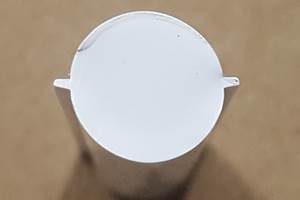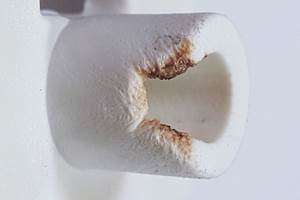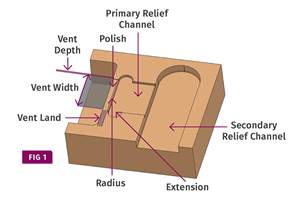Experts Predict the Next Big Thing in Thermoforming
What changes are in store for thermoforming in this decade? We polled nine industry experts on new developments to watch out for in materials, machinery, tooling, and controls.
Ten years from now, thermoformers won’t bat an eyelash when asked to make a structural part with a seven-layer sheet or reinforced composite material. Nor will they raise an eyebrow at twin-sheet forming of beverage bottles or micro-forming of high-tech medical or electronic components. Forming preprinted sheet or in-mold labeling will also be commonplace. Technologically adventurous processors will be running their plants in a fully automated “lights-out” environment, relying on computer process simulation and CNC-controlled machines to minimize human intervention in the process.
Currently available technology provides only a glimpse of these coming advancements in materials, machinery, and markets. But given the pace at which thermoforming is evolving today, these visions of the future could be concrete reality by 2010, says a group of industry experts consulted by PLASTICS TECHNOLOGY. To find out what further strides the process will make in the coming decade, we sought out the opinions of these acknowledged thermoforming “gurus” and other industry figures with no apparent axe to grind.
Consultants: Jim Throne, president of Sherwood Technologies Inc., Hinkley, Ohio; Art Buckel and Bill McConnell, partners in McConnell Co. Inc., Fort Worth, Texas.
Heavy-gauge formers: Stephen J. Murrill, president of Profile Plastics Corp., Lake Bluff, Ill.; Pat Long, president of Formed Plastics Inc., Carle Place, N.Y.; Richard Freeman, president of Freetech Plastics, Fremont, Calif.
Thin-gauge formers: Tom Bush, v.p. of engineering at Fabri-Kal Corp. in Kalamazoo, Mich.
Academia: Donald Hylton, associate director of the Research Center for Science and Technology at Clark Atlanta University, Atlanta.
Tooling: Frank Biller, president of Marbach Tool & Equipment, Elkhart, Ind.
What’s Next in Materials
PLASTICS TECHNOLOGY: What changes do you see in material choices for thermoforming in the years ahead?
Biller: In the U.S. there will be a major move into thermoformed polypropylene lids for deli or yogurt cups—any sort of lid application. About 90% of the market will be a conversion from injection molding. Injection molded lids are extremely heavy, and thermoforming can produce the lid with 50% less material. This is happening now, for both high-clarity and preprinted lids.
Throne: Only now are thermoformers learning to form olefinic materials correctly. Why not go after reinforced or filled composites and make structures out of them? An example may be automotive bracing, where you want a superstructure to lay something on. The structural market is potentially huge, yet a higher level of understanding is required to know what we are doing in this area. The basic philosophy is that you won’t get the same kind of processing from composites as you will from polyolefins that can stretch. You will have to use higher pressures, and you will also need strict temperature control.
Buckel: Look for more thermoformed composite structures in aircraft parts. In Europe they are ahead of the game. They take thermoplastic sheet that coats woven glass or carbon fiber, heat it, and then with tremendous pressure they mechanically push the product into a shape.
The parts are being used for rib shapes inside the wing and in the stabilizer in the tail of the aircraft. These are parts that make you say, ‘Wow, they’ll never make this out of plastic.’ But they are doing it today using commodity resins with carbon or glass fibers.
Murrill: I’m convinced the higher-temperature, higher-performance engineering plastics will have a dramatic role in applications where everyday PE, PP, and PS won’t do. Those [higher-tech] materials are expensive, but eventually their price will come down.
Hylton: We need to more adequately measure viscoelastic material properties that specifically apply to thermoforming conditions and temperatures. At Clark, we are actively looking at these types of properties on a number of different materials such as highly reinforced PP sheet. We are also evaluating high-temperature materials like polyimide composites, which have great potential for structural and high-temperature applications but are very difficult to process.
McConnell: The German thermoformer Manfred Jacob has combined with Portage Casting & Mold [the moldmaker in Portage, Wis.] in a North American operation that is looking for [composite formed] applications here. That union represents a whole new world in composites thermoforming.
PT: Will we see more foamed materials?
Throne: Foamed PET sheet is going gangbusters. It’s been around for 10 years and thermoformers are now getting comfortable with it. PET foam fills a great need in bakery goods. A firm called Genpack has learned how to do it. It thermoforms like a CPET material. The key is to control the crystallization level, keep it low enough (below 20%) so that you don’t break the cells. More than that, and it gets brittle. Eastman was leader in this field in the U.S. Simco in Italy was also pushing the technology, but five years ago the CPET price plummeted and knocked out foam R&D.
Biller: Foamed drink cups are manufactured in a fairly expensive expanded polystyrene process. It’s too early to tell what will happen there with thermoforming, but there are some new ideas already being investigated.
PT: Will crosslinked materials be thermoformed?
Throne: Forming has already been done with a crosslinked polyolefin foam. There’s no reason why a thermoformer can’t use crosslinked sheet. You won’t get a 4:1 draw ratio from it, but you can do it.
PT: What’s the potential of multi-layer structures?
Murrill: What may come are applications requiring soft-over-hard materials, where you want the feel of soft urethane on top of a harder substrate. Multi-layer is also a way to use junk (recycled) layers. Put color matching just in the top, visible layer of the sheet—that can help a former save on material costs.
Biller: We’ve seen packaging applications that use up to seven layers. There’s a sealing surface plus EVOH and other barrier layers. This is for high-shelf life, non-refrigerated products—puddings and snacks like cheese and crackers that need many months’ shelf life. Some uses are also for microwavable products.
Multi-layer sheet potentially has an impact on tool design. It depends on sheet thickness and how the materials bond together.
Thick and Thin
PT: Are there any new opportunities waiting out there for thin-sheet formers?
Throne: Thin-gauge, twin-sheet bottle forming is a major area that really hasn’t been touched. It sounds futuristic, but within the next five years or so I expect someone to ask themselves why can’t they thermoform a bottle. We can do a neck finish. I don’t see any limitation except from a marketing viewpoint. If it is made as a flexible container like a squeeze tube, you could dispense higher viscosity materials.
I worked on PP twin-sheet bottles in the 1980s. But the PP of the day was wrong, and so the bottle was never advertised, never displayed, and is probably languishing somewhere. There was also work on toothpaste tubes as a twin-sheet application a while back. It has not surfaced in the marketplace yet. Also, a major tea company spent money in the late 1970s and early ’80s to develop twin-sheet wide-mouth jars. The project was never commercialized. In Europe in 1997 I saw 1-liter PP twin-sheet containers formed six-up on a 6-sec cycle, something that can’t be matched today in blow molding.
Biller: You could twin-sheet form an insulated drink cup. Instead of having thick foam, you could have an inside and outside layer. We were involved in twin-sheet forming rectangular milk containers a few years ago. Unfortunately, it didn’t take off. You really have to have the right application for it. But technically it is available.
PT: What new challenges and/or opportunities are coming for heavy-gauge formers?
Hylton: There may be a market for micro-forming—producing very tiny parts or packages. There is a developing trend in what’s called nano-technology, involving smaller and smaller parts. One might expect to see tiny parts such as medical implants or microchips, as well as tiny blister packs to hold them. Processing will be critical in such applications. Possibly you could borrow from heavy-gauge technology for precision forming of intricate shapes.
Freeman: We think there is going to be more demand for large parts as time goes on. We have a number of these projects already. Several entries at the annual SPE Thermoforming Conference testify to the strength of this emerging trend.
McConnell: One advantage of twin-sheet is that we can make more complex multi-layered parts. There is now a twin-sheet fuel tank coming on the market in the U.S. and Europe.
Buckel: The appliance market also has new developments. A producer in the U.S. bought tooling to twin-sheet form the inner liner and outside door of a refrigerator. That way they got rid of sheet metal on the outside. It didn’t sell well here. But BASF in Europe has come out with something similar, where inner liner and outer shell are formed at the same time. I don’t know if it has sold yet, but someone will take the idea and go with it.
PT: Can graphics and forming mix?
Bush: There is an opportunity for in-mold labeling to advance in thermoforming. Right now most containers are decorated downstream in a printing process. There can be cost savings for the customer if the technology for in-mold labeling comes around. However, I haven’t seen a system yet that is cost-effective.
Biller: A next step will be forming preprinted sheet for lid applications. This process will require technology that can accurately check the registration of the image, and the sheet indexing has to be repeatable and accurate. In forming lids, there’s not a lot of stretching of the sheet, but you want it to be uniform and controlled. If there is too much or too little stretching, it ruins the image. The tooling also must allow you to get more material into the vertical skirt of the lid, so that the stretching and thinning occur mainly in the sidewall rather than the top. A special heater mask can pull material from the web to the lid, which reduces scrap, while a pre-clamping unit can minimize image distortion.
‘Virtual Thermoforming’
PT: Will process simulation live up to its promise in thermoforming?
Bush: Upfront computer simulation of mold design and material forming presents a great opportunity to cut down on product development time and reduce trial and error. You can couple it with finite-element analysis in order to predict material thickness and stiffness of the final part. Such information could help you redistribute the material thickness to reinforce weaker areas.
Hylton: There is a lot of room for evolution of process-simulation software. It needs to be more user-friendly. As the software advances, it will help determine what sheet temperatures should be used as well as plug-assist type, plug speed, and plug temperature. Process simulation could also help to analyze shrinkage and warpage.
Handle on the Process
PT: What is still left to be learned about process control?
Throne: There needs to be more intelligent use of pressure and temperature. Too few formers use pressure to control their process. Pressure formers know that if they put pressure on a material, they can get good surface-texture transfer from the mold. But they haven’t figured out the relationship between material properties (such as modulus) and the pressure applied.
Also, very few formers control their process based on temperature. Many formers still use timers—1950s technology—or sag sensors. The process characteristics of a roll of material are different at the start, middle, and end of the roll because the material is warming up as processing continues. A timer setting doesn’t take this into account, which can lead to good parts at the start of a roll and bad parts at the end.
Thin-gauge forming machinery lets an operator put more heat into the sheet in the last part of the oven just prior to forming. Processors have not used that part of the oven as effectively as they should, but in five to 10 years you’ll see more of them use it to cut cycle time.
Murrill: Formers will take another look at closed-loop control of the process—where a temperature-monitoring system indexes the sheet when it has reached a given temperature and remained at that temperature for a specified time. Right now that is too high-tech for many applications. The traditional method of sheet temperature control is trial and error. However, the advantage of closed-loop control is the ability to form at the same temperature consistently. There can be different levels of temperature-based process control. An operator with a hand-held pyrometer can read temperature off the sheet and adjust the process parameters. Another way is a fixed spot measurement of the sheet accompanied by automatic feedback. A future development may involve multiple sensors that see more of the sheet more of the time.
Long: Cooling is an area that could be improved in heavy-gauge forming. Large, expensive, heavy-gauge machines still use fans for part cooling. Cooling 1/4-in. or 3/8-in. thick sheet can take up to 50% of the cycle time. Some formers use water-spray mist, but that is messy. There has to be a better way.
Murrill: I’m a strong believer in all-electric machines and microprocessor control. They make a lot of sense from an accuracy and repeatability standpoint. They allow you to manage production differently, generating detailed machine-performance reports on every shift, which gives you a chance to analyze the process for ways to be more efficient.
PT: Is it possible to take the people out of the process altogether?
Buckel: Running in a “lights-out” mode is possible if there is good control of the process. I saw “lights out” applied literally at a plant in Germany years ago. Eight continuous forming machines were running in the dark because no one was working in there. They fed new rolls from a lobby through the wall to the forming room.
Tooling Up
PT: What role will new tooling technologies play in the next decade?
Bush: Porous aluminum tooling is sparking some interest in thermoforming. It’s good because there is no mold mark-off, and perhaps an improved degree of cooling.
Porous tooling will lead to a rethinking of mold design. If thermoformers can get away from the “buttons” you see at the bottom of a product, they can go for a very high-quality finish. This could lead to first-surface molding, where the appearance side of the sheet goes against the mold surface. That is difficult to do today.
Biller: Increasing cavitation within the physical limitations of the forming area is a development challenge. Recent changes in die-plate design are making it possible to reduce the gap between each mold cavity to increase the yield and provide sheet economy. One might thereby get an extra row of cavities in the mold or reduce the material area required for the same number of cavities.
Throne: CNC routers are helping thermoformers turn the corner on faster prototype production. They can get a prototype part in days rather than weeks spent whittling away at wood. Previously, they used routers only to trim parts. Now, they’re making molds this way. It’s a real boom in the industry. Firms are also making prototypes from syntactic foams cut with routers. Foam can be cut into plugs too.
“In the next five years, I expect someone to ask themselves why can’t they twin-sheet thermoform a bottle?” —Jim Throne, Sherwood Technologies Inc.
“Look for more thermoformed composite structures in aircraft parts. In Europe they are ahead of the game. They use commodity resins with carbon or glass fibers.”—Art Buckel, McConnell Co.
“One advantage of twin-sheet is that we can make more complex multi-layered parts. There is now a twin-sheet fuel tank coming on the market.”—Bill McConnell, McConnell Co.
“Multi-layer materials may appear in applications where you want a soft feel on top of a harder substrate.”—Stephen Murrill, Profile Plastics
“Cooling is an area that needs improvement in heavy-gauge forming.”—Pat Long, Formed Plastics
“We think there is going to be more demand for large parts as time goes on. Several entries at the annual SPE Thermoforming Conference testify to the strength of this emerging trend.”—Richard Freeman, Freetech Plastics
“Porous aluminum tooling will lead to a rethinking of mold design. It could lead to first-surface molding, where the appearance side of the sheet goes against the mold surface.”—Tom Bush, Fabri-Kal
“There may be a market for micro-forming—producing very tiny parts such as medical implants or microchips.” —Donald Hylton, Clark Atlanta University
“A next step will be forming preprinted sheet for lids. This will require technology that can accurately check the registration of the image, and the sheet indexing has to be repeatable and accurate.”—Frank Biller, Marbach Tool & Equipment
Related Content
Where and How to Vent Injection Molds: Part 3
Questioning several “rules of thumb” about venting injection molds.
Read MoreHow to Optimize Pack & Hold Times for Hot-Runner & Valve-Gated Molds
Applying a scientific method to what is typically a trial-and-error process. Part 2 of 2.
Read MoreBack to Basics on Mold Venting (Part 1)
Here’s what you need to know to improve the quality of your parts and to protect your molds.
Read MoreBack to Basics on Mold Venting (Part 2: Shape, Dimensions, Details)
Here’s how to get the most out of your stationary mold vents.
Read MoreRead Next
Understanding Melting in Single-Screw Extruders
You can better visualize the melting process by “flipping” the observation point so that the barrel appears to be turning clockwise around a stationary screw.
Read MoreTroubleshooting Screw and Barrel Wear in Extrusion
Extruder screws and barrels will wear over time. If you are seeing a reduction in specific rate and higher discharge temperatures, wear is the likely culprit.
Read MoreProcessor Turns to AI to Help Keep Machines Humming
At captive processor McConkey, a new generation of artificial intelligence models, highlighted by ChatGPT, is helping it wade through the shortage of skilled labor and keep its production lines churning out good parts.
Read More












.png;maxWidth=300;quality=90)
















